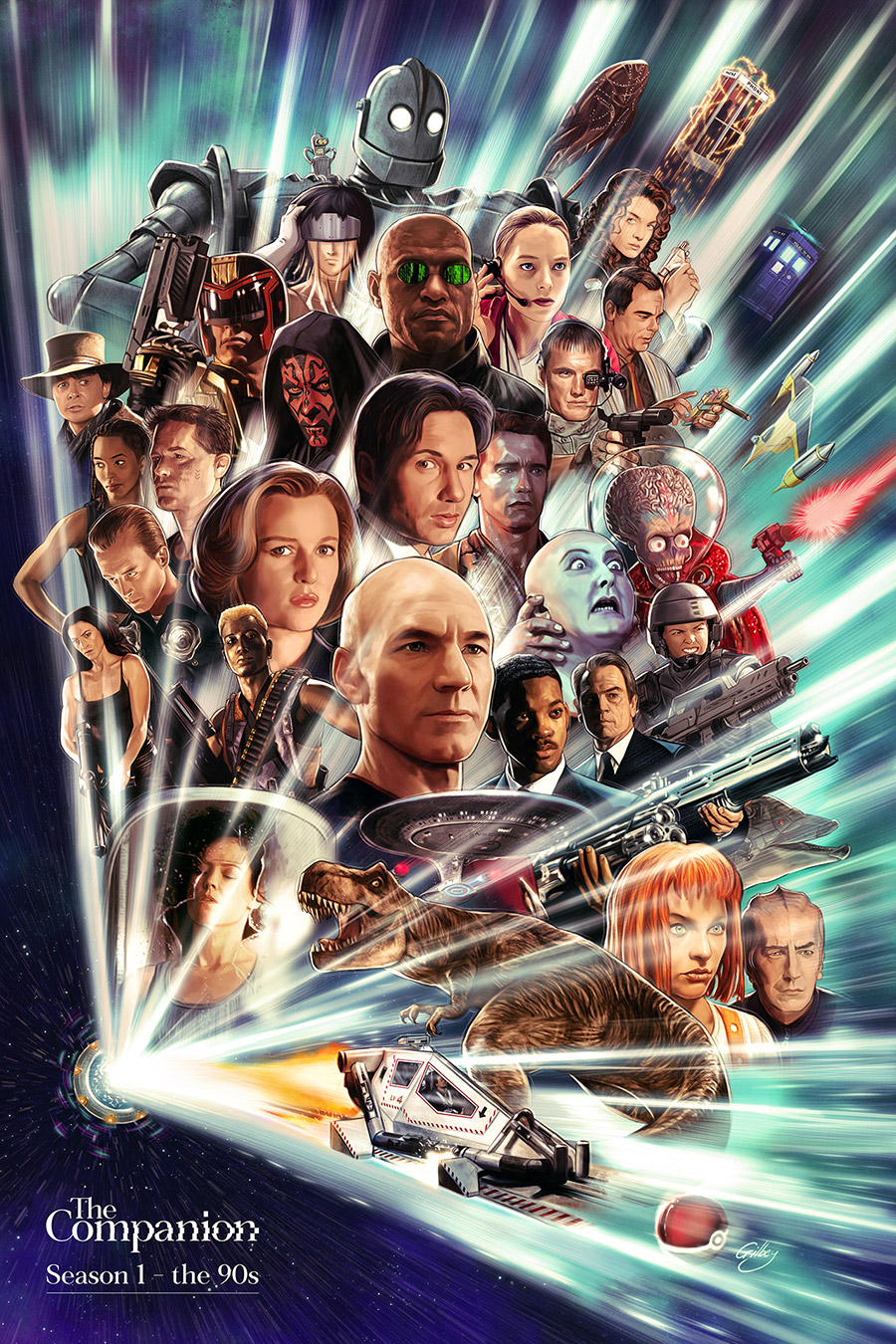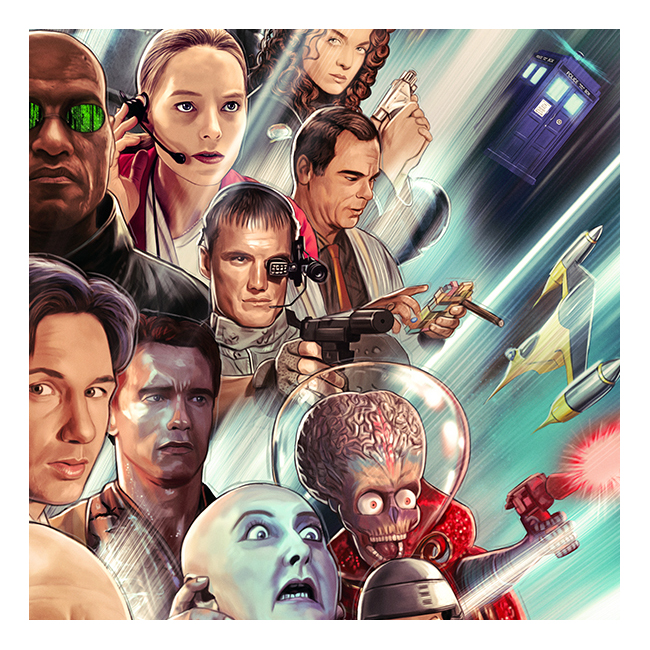The Companion: A New Home for Sci-Fi
Part magazine, Part ‘making of’ companion, Part DVD extras – from the team behind Stargate Command
Our good friends at The Companion recently commissioned AMP artist Sam Gilbey to create a poster for their first season of content “Season 1 – The 90s”.
The Companion is aiming to be the ultimate companion to your favourite Sci-Fi stories: in-depth articles, exclusive podcasts, a positive community, and much more…
We shared it recently on our Instagram account and the Companion team interviewed Sam about the project.

“The Companion: Season 1 – the 90s” poster by Sam Gilbey
Be sure to back the Kickstarter if you want to get in the mix and enjoy this fascinating Q&A with Sam!
The Companion Interview with Sam Gilbey
Can you explain to the readers what the brief you were given was for The Companion piece?
I initially spoke with Lawrence and Tommy over a video call, and at that point there was a general notion of showing a number of iconic science fiction titles in the poster. The piece that had actually led them to me was a private commission I did of an 80s space diner featuring a slew (not sure if that’s the correct collective noun) of movie stars that went into space, with everyone seated in different social groups. You can see that at https://www.samgilbeyillustrates.com/portfolio/in-the-crowd. Whilst it might have been fun to do another, something like that represents months of work, and although there was a good chunk of time before the launch, it became apparent that a montage would be more effective in this case. We also chatted about possibly limiting it to featuring characters who are ‘companions’. I still like that idea in theory, but in practice it soon became problematic. Frankly it was more fun to mostly paint main characters, as well as including some more obscure ones. I think Lawrence made the initial suggestion of having characters emerging from a Stargate, and everything went from there.
Is there a first step in the process that’s always pretty similar, or do different pieces require different approaches?
The first step of the process is always the same, in that I panic until I know what I want to do! But once I do, I quickly switch to excitement, before carrying right on into stress as I realise how hard it’s going to be. That said, with a collage such as this, the challenge is solving the puzzle of how everything can work together, and I really love that process when it finally starts to come together, but your original vision remains (mostly) intact.
How important was it to have the Stargate as the point from which everything is emerging?
It was really important in that it enabled me to include more characters that I normally would, and therefore could be pretty exhaustive with the shows and movies covered. In a way the whole point is that it’s pretty over the top, in terms of how dense it is, but then I’m able to use that vanishing point to build the overall structure and have fun with that premise. So things like having the guns of the Men in Black characters and the Starship Trooper follow those lines are crucial, to mention one obvious example.
“I’m pretty well-versed in 90s sci-fi, and saw a lot of the movies on the big screen at the time”
Were there any figures in the piece that you were previously unfamiliar with?
Yes, a few of them. I would say I’m pretty well-versed in 90s sci-fi, and saw a lot of the movies on the big screen at the time, but then it’s all relative isn’t it, because you can’t see everything. I admit that I wasn’t very familiar with either Farscape or Babylon 5, for example. Still, of course many people are, so I wanted to have something in there for as many different fan groups as possible, and didn’t want it to just be my own limited memories. Though I still had to get Timecop in there!
What are the biggest challenges of a big collage piece like this?
It’s just that the initial planning take so long, and you’re aching to get onto the painting, but instead you’re endlessly shifting things around in a horrible Photoshop collage of found elements where you’re squinting at it, trying to keep believing that this will all work as a painting when you’re finally able to start it. Actually though, I also deliberately planned this to have some flexibility. I designed it to be able to get more complex, partly in case I forgot anybody really important. Plus we also wanted to reveal a teaser of the artwork, and only release the whole thing the day the Kickstarter went live. In essence, by the end I had zoomed out a far bit further than I had originally planned to, and the aperture of the Stargate was a few degrees wider! But the Iron Giant was always there to ‘hold’ everything in place. If this were a movie, it’s at the point where the portal ‘can’t take any more’, but the heroes find a way to close it back up before it explodes!
“The Companion is really trying to be something special for fans of lots of different shows and movies”
Lawrence mentioned that the original idea was much smaller, what was behind your decision to go bigger and what was that process like?
My decision was partly that I can’t help myself, but also, more importantly because The Companion is really trying to be something special for fans of lots of different shows and movies. Whilst the painting is really only a surface level collection of characters and items, the idea was that the breadth of it would share the aspirations of the app, i.e. that sci-fi is a broad church. It also came from their idea of limiting Season 1 to the 90s. Without that focus, a more random assortment would have been possible. So I suppose it was that and I was worried about fans of certain shows being disappointed if I left them out, and therefore not investing. I have no idea if by including say, Quantum Leap, it had a direct affect on anyone backing it, but I did try to go as far as I could, insofar as timings and budget realistically allowed, as well as the most important aesthetic concerns of course.
Was there anything you were particularly excited about bringing to life?
I find with a piece like this, I enjoy the work it takes to create each element, but I get a kick from the unusual juxtapositions, such as the two phone-boxes, from Bill and Ted and Doctor Who respectively, or having the martian from Mars Attacks! next to Arnie. The joy of it comes from gradually swapping out the references with the paintings, which is of course slow and incremental, but then it’s that final 10% of making it all work together where it finally feels enjoyable, and you get the payoff for all the planning and adjusting.
I wanted to ask about the top level, where you have the Iron Giant, Bender, and the Major. Is it tough to blend illustrations of “live-action people” and animated characters?
 I loved adding those characters, especially when I realised that Bender could just be sitting on the Iron Giant. Whilst I took a cursory look at the Iron Giant in Ready Player One, generally I see that as part of the same process really. By that I mean, painting a portrait from a photographic reference is about processing that persona and personality through your style, so that, with a collage like this, you get a cohesive overall aesthetic. The initial references may have been flat for those characters you mention, but it was fun to hopefully render them just enough where they work with everything else, but are still recognisable.
I loved adding those characters, especially when I realised that Bender could just be sitting on the Iron Giant. Whilst I took a cursory look at the Iron Giant in Ready Player One, generally I see that as part of the same process really. By that I mean, painting a portrait from a photographic reference is about processing that persona and personality through your style, so that, with a collage like this, you get a cohesive overall aesthetic. The initial references may have been flat for those characters you mention, but it was fun to hopefully render them just enough where they work with everything else, but are still recognisable.
Was there anything that you just couldn’t find a space for?
Honestly there are several things that I would have loved to have squeezed in, but I couldn’t possibly say, as I won’t be able to sleep with the feelings of guilt! That said, overall I’m proud of the balance it strikes between having ‘mainstream’ sci-fi and some slightly more, it’s probably safe to say, obscure references also.
“I’m saying that Predator 2 is in there in camo!”
Is there an Easter Egg or smaller figure in there that you’re particularly fond of?
 It’s probably Bender sitting on the Iron Giant. That was a good feeling when it came to me. And relating to the question above, I’m saying that Predator 2 is in there in camo!
It’s probably Bender sitting on the Iron Giant. That was a good feeling when it came to me. And relating to the question above, I’m saying that Predator 2 is in there in camo!
When did you first know that this was a career path you wanted to pursue?
I always knew I wanted to make art for a living, but I didn’t always see how I could get there. It felt to me like you could either sell paintings in small boutique London galleries (if you got lucky), or be an art teacher, without many options in between. Luckily though, I spent a long time working in graphic and interface design, which I also really enjoyed honestly, but because I was freelancing I was able to illustrate too, often for fun but sometimes for money (and fun!), and gradually over time, art became my sole focus.
How did you find your creative style?
I think when you first start painting it’s like being in a new band, and you start by playing covers. You’re trying to channel your favourite things before you know how to really make your own from scratch. For me those things were, to name a few in no particular order, David Hockney’s paintings, animé, Marvel and 2000AD comics. As the years pass, you slowly end up with something unique and you’ve kinda forgotten where you started. It’s a combination of your own taste, plus some of the direction you get nudged in along the way too I think, whether it’s by teachers or peers. But then it’s also always evolving, and I think most artists look back at work from even a few years ago and would approach them differently now. I certainly do anyway!
How is the process different when a studio approaches you with a commission, as opposed to a publisher?
It really depends honestly, but wherever they come from, the best projects tend to be the ones where you’re able to lead it, and go with your creative instincts, but it’s also a collaboration with the client. They want you run with it, so to speak, but are able to give constructive feedback along the way.
As an artist, how much direction do you like to be given? Or is it best when someone says “Back to the Future! Go for it!”
 If there’s a client expecting a certain thing from you, then a clear brief is essential. It often helps if a client shows you examples of your work that they like too. On the flip-side though, it’s wonderful to be able to make a poster for a movie where you can explore the ideas in your head for as long as you need, not necessarily constrained by a brief (or a deadline). But I always show things like that to creative friends I trust, and my amazing wife too, because seeking constructive criticism is always important.
If there’s a client expecting a certain thing from you, then a clear brief is essential. It often helps if a client shows you examples of your work that they like too. On the flip-side though, it’s wonderful to be able to make a poster for a movie where you can explore the ideas in your head for as long as you need, not necessarily constrained by a brief (or a deadline). But I always show things like that to creative friends I trust, and my amazing wife too, because seeking constructive criticism is always important.
“I would love to be able to make more official artwork for Marvel and Star Wars”
Is there a dream commission that you’d love to get?
I’ve been very lucky to have had a few of those already, as in, projects I couldn’t have imagined would come to me, and I’m very grateful that they happened. If I were to be greedy though, I would certainly love to be able to make more official artwork for Marvel and Star Wars someday!
What’s the most interesting thing about The Companion for you?
Speaking to Lawrence and Tommy, they’re clearly very passionate about what they’re building, and I suppose that’s the core of what drew me to it really, as well as my own passion for sci-fi, and a longing for long articles unencumbered by advertising! In any case I was happy to make a small contribution towards them (and the rest of the team) getting the funding they need to do it right, and I can’t wait to see the app, and explore the content.


